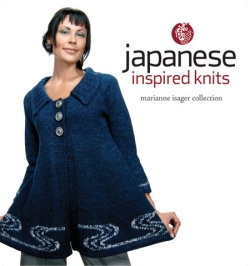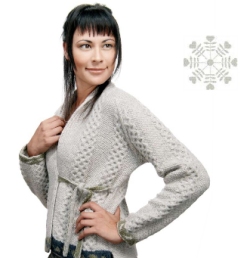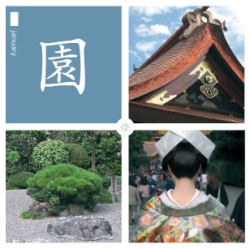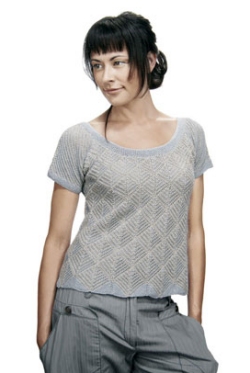 Title: Japanese Inspired Knits: Marianne Isager Collection
Title: Japanese Inspired Knits: Marianne Isager Collection
Author: Marianne Isager
Publisher: Interweave Press
Paperback; 144 pages
Suggested Retail Price: US $22.95, UK £16.99
Available from: Amazon US/ Amazon UK
Marianne Isager draws from nature and the countries where she travels and teaches to create her elegant knitted designs. Her most recent book available in English, Japanese Inspired Knits, presents twelve sweaters and jackets organized around the visually dynamic seasons and festivals of Japan and realized through European styling and techniques.
Although the book includes illustrated directions for the featured techniques including double knitting, entrelac, fair isle, cables and intarsia, these projects aren’t for beginners. Intermediate and advanced knitters will appreciate the range of styles from classically shaped Arans and delicately feminine lace, to those that echo more distinctly Japanese silhouettes. One pink confection of a cardigan, aptly named The Fan, is a marvel of design, radiating out from each underarm to graceful front edges bordered in a lacy fan pattern.
 Attention to detail distinguishes these designs from many you see elsewhere. Stone Garden Jacket, for example, uses all natural colored wool and alpaca in seed stitch and an Aran pattern. A simple geometric double knitted border around the wrists couples the natural color against a grayed olive background. The front right panel picks up patterning, this time with small stone shapes in light gray and steel blue against the grayed olive. The left front border mirrors those colors while the same grayed olive subtly backs the ties that are used for closure. These varied but coordinated details suggest the controlled patterns and contrasts celebrated in Japanese gardens.
Attention to detail distinguishes these designs from many you see elsewhere. Stone Garden Jacket, for example, uses all natural colored wool and alpaca in seed stitch and an Aran pattern. A simple geometric double knitted border around the wrists couples the natural color against a grayed olive background. The front right panel picks up patterning, this time with small stone shapes in light gray and steel blue against the grayed olive. The left front border mirrors those colors while the same grayed olive subtly backs the ties that are used for closure. These varied but coordinated details suggest the controlled patterns and contrasts celebrated in Japanese gardens.
Most of the knitwear is constructed from fingering weight yarn, often used doubled, from Isager’s own line of natural fibers. These are mostly of wool and alpaca but with a few cotton or viscose/linen blend offerings. The yarns are not widely distributed but her website lists mail order and retail sources. A page of yarn quantity substitutions for the U.S. was included as a separate sheet of paper with my copy of the book. Sometimes the two strands used together are slightly different colors, a choice that adds a subtle texture to the patterns.
 Isager writes a brief paragraph describing each month as celebrated in Japan. I would have enjoyed more explanation, including a bit of information on Japanese garments. Still, my curiosity led me to discover a charm of the book that I might have overlooked otherwise. As I studied the design of Winter in Tokyo, a modern urban tunic alternating white with black and white striped entrelac squares, I struggled to find any Japanese influence. Flipping through the book, however, I discovered a photograph of a rainy city street, with pedestrians streaming across the black and white striped crosswalk set against the strong geometric backdrop of buildings and signs, which may well have been the influence for the design.
Isager writes a brief paragraph describing each month as celebrated in Japan. I would have enjoyed more explanation, including a bit of information on Japanese garments. Still, my curiosity led me to discover a charm of the book that I might have overlooked otherwise. As I studied the design of Winter in Tokyo, a modern urban tunic alternating white with black and white striped entrelac squares, I struggled to find any Japanese influence. Flipping through the book, however, I discovered a photograph of a rainy city street, with pedestrians streaming across the black and white striped crosswalk set against the strong geometric backdrop of buildings and signs, which may well have been the influence for the design.
In another instance, the Sake and Soba tunic, which on first glance presents as a traditional Aran cable design, upon closer inspection reveals patterning featured in the photos of sushi and noodles at the beginning of the chapter. The zip-up cardigan, Ricefields, suggests the aerial view of blocks of agricultural land. Featuring castellated tabs at the bottom edge reminiscent of o-yoro samuai armor, this piece in gray and two shades of green calls for stranded knitting. The Carp, a short sleeve pullover constructed from mitered squares of the palest blue and tan, uses viscose and linen yarn worked together to create an elegant look subtly hinting at fish scales.
A number of patterns call for entrelac construction. Indigo, a short button up coat in the titled deep blue color, mixes a modern collared scoop neckline with a white, swirly ribbon-like design on the bottom that suggests ikat, the Japanese resist-dye technique. The author offers a single color alternative to another entrelac piece, the lacy flared cardigan, Maple Leaves.
 Instructions offer small, medium and large sizes so knitters wanting anything larger will have to fuss with the math to resize. For some of the designs, Isager offers variations on the patterns: shorter or longer sleeves, smaller or larger prints, or single or multiple colors.
Instructions offer small, medium and large sizes so knitters wanting anything larger will have to fuss with the math to resize. For some of the designs, Isager offers variations on the patterns: shorter or longer sleeves, smaller or larger prints, or single or multiple colors.
The handsome book design complements Isager’s work. Along with the stunning photographs (some taken by the author herself) the book incorporates Japanese ideograms and monsho or traditional stylized medallion crests. Also included are a glossary and illustrated knitting stitches.
Isager’s other books Knitting Out of Africa: Inspired Sweater Designs and Inca Knits: Designs Inspired by South American Traditions (to be released in late 2009) also fuse European elegance with decidedly non-European patterns and designs influences. Those who enjoy exquisite design from a master artist will want to include Japanese Inspired Knits in their libraries.
Margaret Thomas Kelso is a writer and educator who has added her new passion for knitting with her long time passion for books. She lives in the heart of the redwoods six hours north of San Francisco. She is on Ravelry as Margaret924.

I am knitting the carp sweater and just finished square 77 and starting 78, pick up and knit 11 sts along selvedge at end of RS rows of Square 77,pm, pick up and knit 13 sts along selvedge of square 63-25 sts. If I do this there is one edge of square 77 left open. What am I not understanding? Thank you Karen